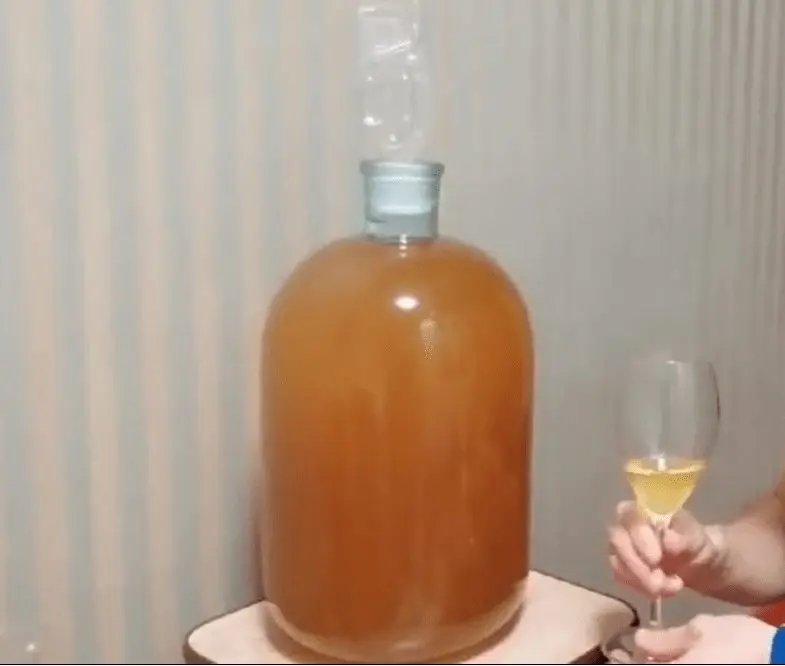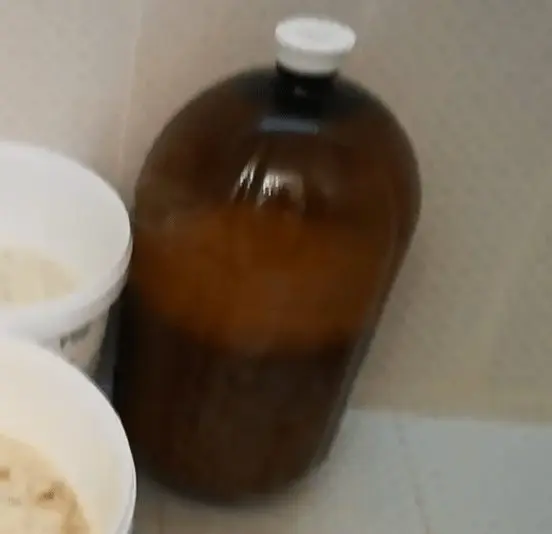Autumn is over, the fruit season, it would seem, has departed and the winemaker can calmly rest from his wine business, sit in an armchair and contemplate with satisfaction the gurgling of pot-bellied bottles with the future product. But it was not there! After all, right now, smiling Caucasians bring the sweetest persimmon to the markets – the main fruit of the beginning of winter, from which you can also make excellent and very original wine! So you will have to again get all your tubes-siphons-sugar-meters from the mezzanine, arm yourself with wine yeast and proceed to the sacrament.
Persimmon – that fruit! Firstly, in nature it has practically no analogues – almost all species of the Ebony family – about half a thousand – belong to the persimmon genus, the closest of the known relatives is an ebony. Secondly, this fruit lives on almost the entire globe, especially in tropical regions. And thirdly, not a single fruit even remotely resembles a persimmon in taste. This is such a unique fruit. The composition of persimmon cannot be called ideal – it contains only 0.2% acids, therefore, when making wine from persimmon at home, we cannot do without additional acidification. But persimmon is quite sugary – 16.8%, it contains a lot of tannins and other tannins, which makes it possible to obtain from it a fairly strong and durable drink, resistant to diseases, souring, mold.

But the main thing in persimmon (does not sound better than “persimmon”) wine is, nevertheless, its taste. With a not very bright aroma, the drink has a marvelous sweet-tart original taste – it will certainly be recognized and appreciated by persimmon lovers who will be able to “taste” their favorite fruit at any time of the year, and not just in winter! And for people who are indifferent to persimmon, this wine leaves the warmest and sunniest impressions, enhanced by a beautiful shade – from straw to bright pink. They say that the “correct” persimmon wine is vaguely reminiscent of sherry – if you are going to fix it, it is better to use persimmon moonshine, which is very popular in the Caucasus and Asia – I will definitely write a separate article about it someday. But we already have an article about tinctures and liqueurs from this fruit – I recommend reading it if you like drinks stronger and sweeter.
In search of adequate recipes in Runet (life teaches nothing), I added to our already permanent rubric “curiosities”. One of the sites from the category “oh, girls!” recommends adding wine soot to persimmon wine! Listen again – “wine soot”! I took the time to google. Found that here, most likely, refers to the yeast sediment from the wine. Why dead yeast is needed in wort is a mystery.
The author on the same site claims that without this mysterious ingredient wine – attention! – “practically does not wander.” Yep, the Philosopher’s Stone. And in the absence of “soot” recommends replacing it with … “ordinary alcohol.” True, he immediately authoritatively declares that the result will not be wine, but tincture. How not to quote from the Formula of Love here: “It’s a sin to laugh at the poor – well, look at them, forced people …”
Persimmon wine at home – winemaking technology
The recipe is complex, mainly not even because of the technology, but because of the many winemaking additives – a mixture of acids, pectin enzyme, potassium metabisulphite, as well as special wine yeast and a nutrient medium for them. I must say right away that some of the ingredients can be abandoned without a twinge of conscience (for example, metabisulphite is just a sulfur-based preservative, our editor-in-chief wrote a detailed analysis about it, and the pectin enzyme in this case is used to precipitate tannin – to rid the wine of excessive “viscosity “). Others – replace with simpler analogues – for example, instead of an acid mixture, we often use lemon juice, although this is not entirely correct. In any case, all these ingredients are sold in winemaking online stores, and below will be another recipe for persimmon wine, simpler – you can not philosophize, but simply use it.

- mature persimmon – 3 kg
- sugar – 900 grams
- water – 7 liters
- acid mixture – 2 tablespoons
- pectin enzyme – 1 teaspoon
- potassium metabisulphite or equivalent – 2 tablets
- yeast nutrition – 1 teaspoon
- wine yeast (for red wines, champagne or multiflor) – per 10 liters of must
Despite the impressive list of ingredients, there is nothing revolutionary in the preparation of this wine, there is a minimum of fuss here – that’s the point, that enzymes will do almost everything for us.
- First, you need to rinse the persimmon and cut it into quarters, remove the seeds along with the seed bed, put it in a fermenter and lightly crush it, for example, with a wooden spoon. Add all the water, the acid mixture, half the sugar there, stir until the latter is dissolved.
- If you use sulfur (metasulphite) – crush the tablet and add it to the wort, stir again and leave the whole thing for 12 hours. The goal is to kill wild yeast that may have been left on the fruit. However, you can do without this item – purchased wine yeast is able to cope with the savages themselves, no one has canceled the “killer principle”.
- To soften the fruits, destroy the fibers and release the maximum amount of juice into the wort, it is recommended to add pectin enzyme. After making the mass, stir well, cover and leave for 12 hours.
- It’s time to add yeast and top dressing. It is advisable to pre-ferment CKD in a small amount of warm water with sugar, even if it says on the package that this is not required – the cases are different, it is better to make sure that we bought good, working yeast with a normal shelf life than to spoil the entire batch of wine.
- Now you need to install a water seal on the bottle, rearrange it in a warm dark place. Primary fermentation will last 5-7 days, at the end of fermentation, the must must be roughly squeezed out and filtered. It’s okay if the small fruit residues are not filtered out – then they will simply precipitate, and we can easily get rid of them by decanting.
- In the resulting “young wine”, you need to dissolve the rest of the sugar, pour it into a smaller bottle – so that no more than 90-95% of its volume remains free, re-install the water seal and rearrange it in a dark place with a temperature of 10-12 °.

- Secondary fermentation will proceed slowly and for quite a long time – up to 6 months. At this time, the wine must be drained several times from the sediment through a tube or a special siphon – decanted – this will allow the drink to lighten and not acquire a bitter yeasty taste.
After the wine has become completely light, dry in taste, and the sediment no longer falls, it can be bottled. If necessary, the drink is stabilized, sweetened, and then bottled. It is recommended that persimmon wine prepared according to this recipe mature for at least a year – only then it acquires a full, refined taste, becomes as fragrant as possible and can properly please its creator!
A simple persimmon wine recipe
This recipe is much simpler and more versatile, it does not require any additional ingredients, with the exception of a pure yeast culture and top dressing for it. Lemon is used to acidify the wort. Also, some experimenters add nutmeg to the must to give the wine a light spicy aroma – but only a couple of pinches per liter of must, no more!

- ripe persimmon – 6 kg
- water – 5 liters
- sugar – 1300 grams
- juice of one lemon (5 g / 1 l of citric acid wort)
- wine yeast – for 12-15 liters of must
- feed for yeast
Preparing a drink is quite simple, to produce such wine from persimmon at home, you only need raw materials, a blender or a meat grinder and a couple of suitable bottles for primary and secondary fermentation.
- Persimmons need to be washed, pitted and white inedible core, unceremoniously mashed with a blender into a puree. Dissolve 700 grams of sugar in puree, add yeast, top dressing, cover with a dense cloth so that oxygen can penetrate into the wort.
- Leave in a warm place for 3 days. 3-4 times a day, the mass must be thoroughly stirred with a wooden spoon so that the foam cap does not turn sour. As a result of this process, called “fermentation”, the persimmon pulp will soften and release juice – the same thing, only faster, pectin enzyme did in the last persimmon wine recipe.
- When three days have passed, we need to squeeze and strain the mass with a dense cloth, gauze or, for example, a special bag for mashing malt. We throw away the pulp – there is nothing useful left in it.
- Now it’s time, in fact, to compose the wort. The resulting persimmon juice is diluted with water, add the remaining sugar and lemon juice. You can and should try the liquid – it should not be either too sour or too sweet, we focus on our own feelings and / or winemaking devices – a sugar meter and a pH meter, the optimal acidity of the must is 0,7%, sugar content – 20-21%, taking into account the fact that part of the sugar has already been processed during fermentation.

- Pour the wort into a bottle or other fermenter with a water seal, rearrange in a dark, warm place. The future wine will ferment for another 4-7 days, depending on temperature and other factors. When all the dense substances move to the bottom of the bottle, forming a sediment, the drink will lighten slightly and stop foaming – the process is over.
- Now the wine must be drained with a straw and transferred to another vessel, smaller – the liquid should occupy at least 90% of the volume. We rearrange the wort for secondary fermentation in a cool – 12-15 ° – place. Fermentation will continue for about 4-5 months, until the wine is completely clarified. During this time, at least 3-4 times you need to decant – drain the wine from the sediment. When the drink has become completely light and the sediment no longer forms, the young wine is considered ready.
What to do next? There are several options. The drink must be tasted (yes, you will have to overcome yourself) – if all the sugar has fermented and the wine tastes completely dry, then everything went according to plan. It can be left to mature in this form, also at home, persimmon wine can be fixed with strong alcohol – best of all, fruit distillate, ideally made from the same persimmon. For information on how, with what and why to mount, read the article at the link. In any case, before tasting, dry wine needs to age at least six months, and fortified or sweetened wine – at least 9 months. Yes, you will have to wait, but believe me – it’s worth it, aged wine will be two heads higher in taste and aroma. In general, good luck to you and patience!









